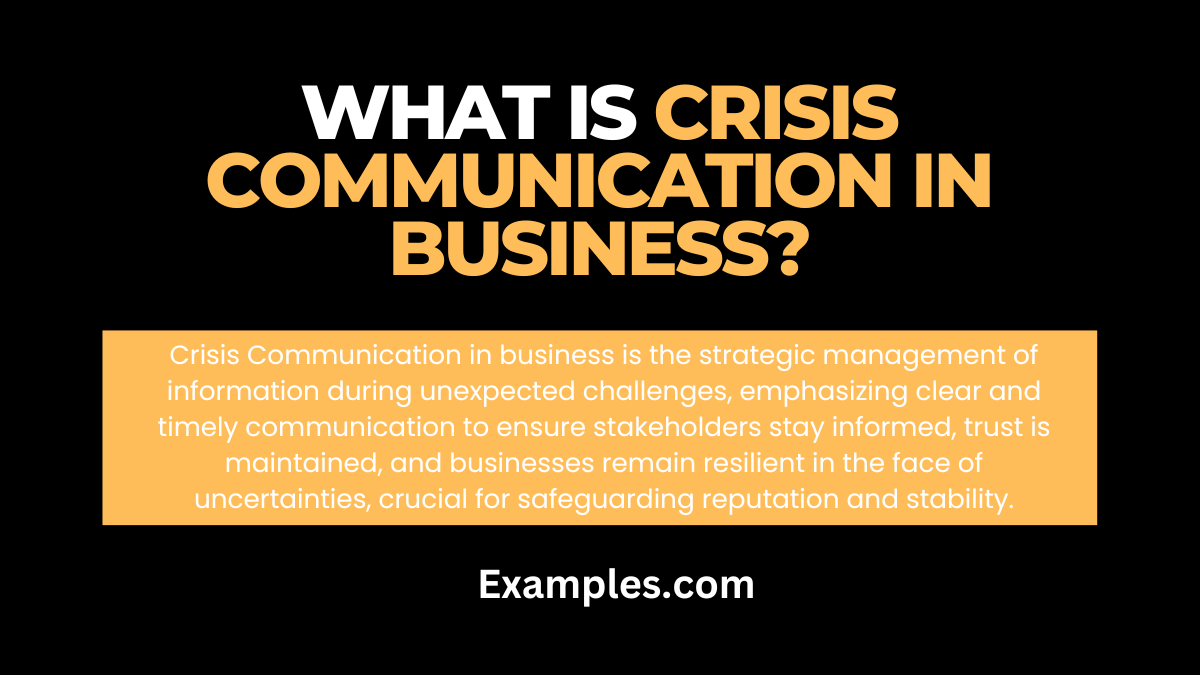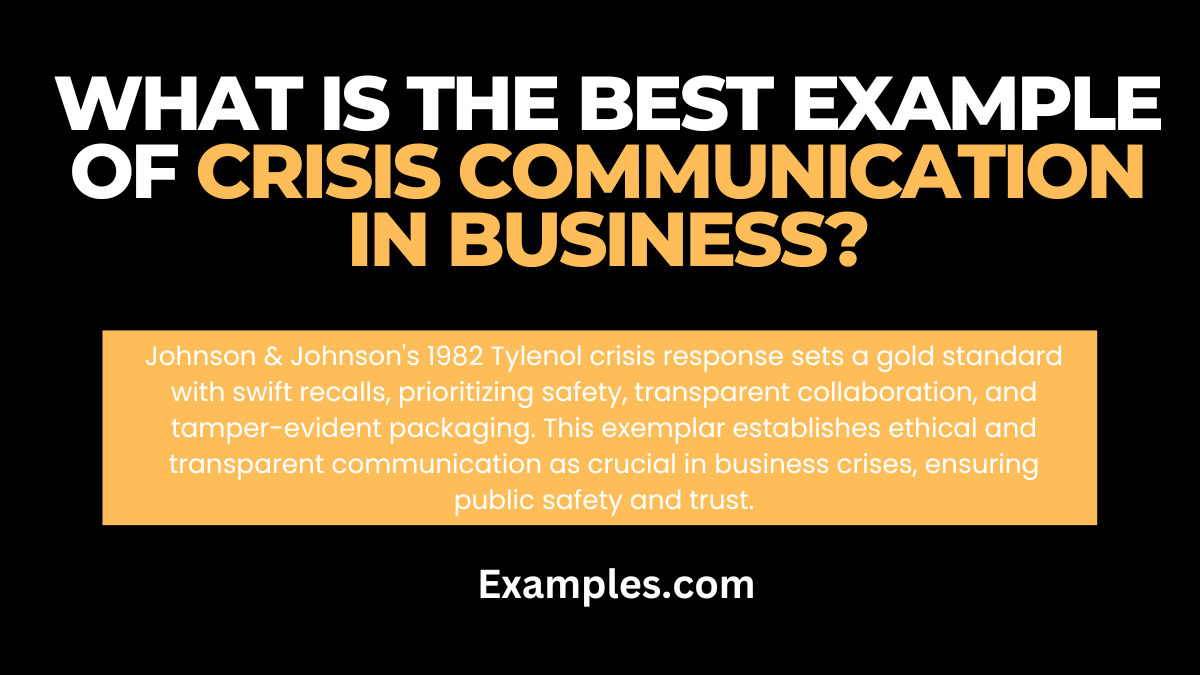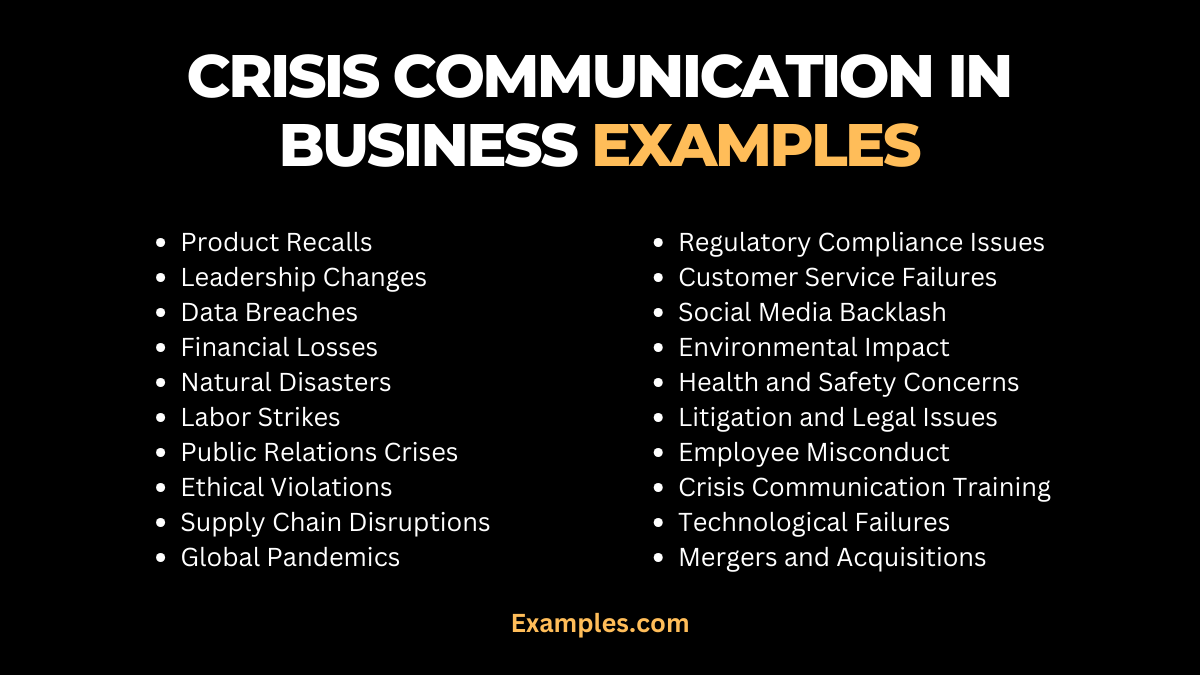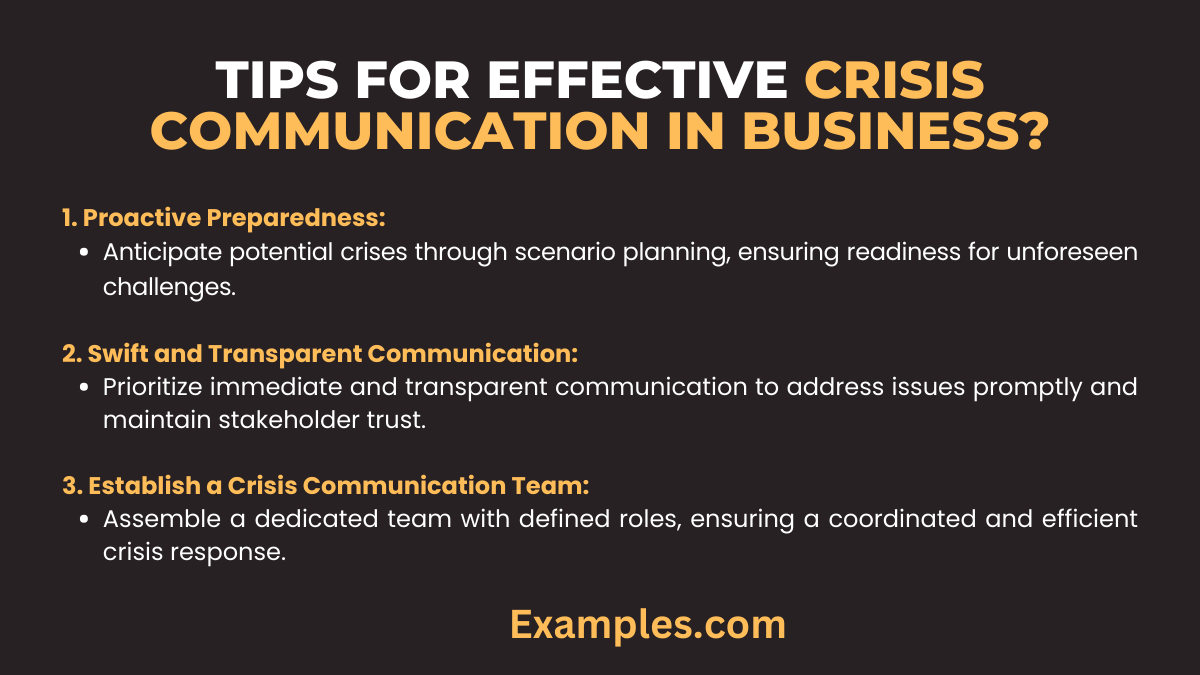Crisis Communication in Business
Unlock the art of Crisis Communication in Business with our comprehensive guide. Delve into real-world Communication Examples that showcase effective strategies for navigating unexpected challenges. From transparent responses to maintaining stakeholder trust, this guide equips you with actionable insights to ensure your business communicates with resilience and success in times of crisis. Explore the power of strategic communication, learning from diverse examples that illuminate the path to effective crisis management and reputation safeguarding.
What is Crisis Communication in Business?

Crisis Communication in business refers to the deliberate and strategic process of managing and disseminating information during unexpected events or challenges. In simple terms, it involves clear, timely communication to address and navigate uncertainties, ensuring stakeholders remain informed, trust is maintained, and the business community stays resilient in the face of unexpected situations. This approach is crucial for safeguarding the reputation and stability of businesses during crises.
What is the Best Example of Crisis Communication in Business?

One of the most commendable instances of Crisis Communication in business is Johnson & Johnson’s handling of the Tylenol poisoning crisis in 1982. Faced with a life-threatening situation due to product tampering, the company took immediate action by recalling all Tylenol products nationwide. Johnson & Johnson prioritized public safety, collaborated transparently with authorities, and introduced tamper-evident packaging. This swift, open, and responsible approach not only safeguarded consumers but also set a gold standard for crisis management, emphasizing the pivotal role of ethical and transparent communication in business during challenging times.
20 Crisis Communication in Business Examples

In the world of Crisis Communication in business, mastering diverse scenarios is crucial. Explore these 20 distinctive examples, each accompanied by a two-line explanation and effective communication sentences:
- Product Recalls:
- Swiftly announce recalls to prioritize customer safety,
e.g., “Ensuring customer safety, we recall product X due to potential defects.”
- Swiftly announce recalls to prioritize customer safety,
- Leadership Changes:
- Communicate leadership transitions transparently for stakeholder reassurance,
e.g., “Announcing CEO change, ensuring continuity and growth.”
- Communicate leadership transitions transparently for stakeholder reassurance,
- Data Breaches:
- Address data breaches promptly, emphasizing security measures,
e.g., “Securing data integrity after a breach, implementing advanced cybersecurity measures.”
- Address data breaches promptly, emphasizing security measures,
- Financial Losses:
- Mitigate concerns by transparently discussing financial setbacks,
e.g., “Addressing losses, outlining strategic recovery plans for investor confidence.”
- Mitigate concerns by transparently discussing financial setbacks,
- Natural Disasters:
- Assure stakeholders with clear communication during natural disasters,
e.g., “Facing adversity, ensuring employee safety and swift recovery efforts.”
- Assure stakeholders with clear communication during natural disasters,
- Labor Strikes:
- Maintain transparency during labor strikes, addressing concerns openly,
e.g., “Navigating labor strikes, prioritizing fair negotiations and employee welfare.”
- Maintain transparency during labor strikes, addressing concerns openly,
- Public Relations Crises:
- Handle PR crises by acknowledging issues and outlining corrective actions,
e.g., “Addressing PR concerns, fostering transparency and rebuilding trust.”
- Handle PR crises by acknowledging issues and outlining corrective actions,
- Ethical Violations:
- Confront ethical violations by transparently addressing concerns and enforcing corrective measures,
e.g., “Upholding ethics, taking swift action to rectify violations.”
- Confront ethical violations by transparently addressing concerns and enforcing corrective measures,
- Supply Chain Disruptions:
- Communicate supply chain disruptions with transparency and alternative plans,
e.g., “Navigating disruptions, ensuring seamless operations with alternative suppliers.”
- Communicate supply chain disruptions with transparency and alternative plans,
- Global Pandemics:
- Assure stakeholders during pandemics with safety measures and contingency plans,
e.g., “Prioritizing safety during pandemics, implementing remote work and health protocols.”
- Assure stakeholders during pandemics with safety measures and contingency plans,
- Regulatory Compliance Issues:
- Address compliance issues transparently, detailing corrective actions taken,
e.g., “Ensuring compliance, implementing measures to meet regulatory standards.”
- Address compliance issues transparently, detailing corrective actions taken,
- Customer Service Failures:
- Apologize for service failures, offer solutions, and demonstrate commitment to improvement,
e.g., “Rectifying service issues, providing immediate solutions and improving processes.”
- Apologize for service failures, offer solutions, and demonstrate commitment to improvement,
- Social Media Backlash:
- Manage social media backlash by addressing concerns openly and demonstrating commitment to improvement,
e.g., “Addressing social media criticism, actively engaging with customers for resolution.”
- Manage social media backlash by addressing concerns openly and demonstrating commitment to improvement,
- Environmental Impact:
- Handle environmental impact crises by acknowledging responsibility and outlining sustainable practices, e.g., “Committing to environmental responsibility, implementing sustainable practices after impact.”
- Health and Safety Concerns:
- Communicate health and safety concerns by prioritizing transparent information dissemination,
e.g., “Prioritizing safety, openly communicating measures to address health concerns.”
- Communicate health and safety concerns by prioritizing transparent information dissemination,
- Litigation and Legal Issues:
- Address legal issues transparently, detailing actions taken and commitment to compliance,
e.g., “Facing litigation, transparently communicating legal actions and commitment to compliance.”
- Address legal issues transparently, detailing actions taken and commitment to compliance,
- Employee Misconduct:
- Handle employee misconduct by acknowledging issues, ensuring fair investigations, and implementing corrective actions,
e.g., “Addressing employee misconduct, prioritizing fair investigations and corrective measures.”
- Handle employee misconduct by acknowledging issues, ensuring fair investigations, and implementing corrective actions,
- Crisis Communication Training:
- Proactively communicate crisis communication training initiatives for organizational preparedness,
e.g., “Investing in training, ensuring organizational readiness for effective crisis response.”
- Proactively communicate crisis communication training initiatives for organizational preparedness,
- Technological Failures:
- Communicate technological failures transparently, detailing recovery plans and preventive measures, e.g., “Addressing tech failures, implementing recovery plans and enhanced safeguards.”
- Mergers and Acquisitions:
- Navigate mergers and acquisitions by transparently communicating changes, benefits, and strategic alignment,
e.g., “Navigating M&A, ensuring transparent communication and organizational synergy for success.”
- Navigate mergers and acquisitions by transparently communicating changes, benefits, and strategic alignment,
Crisis Communication in Business for Employees
Effectively communicate with employees during crises to foster resilience and maintain trust.
- Remote Work Transition: Guide employees through the shift with detailed instructions and tech support.
- Financial Downturn: Transparently address challenges and outline support measures for employee well-being.
- Employee Health Concerns: Prioritize health, ensuring transparent communication and stringent safety measures.
- Leadership Changes: Announce changes with continuity and foster a positive outlook for the organization.
- Team Conflict Resolution: Resolve conflicts transparently, ensuring a fair and supportive resolution process.
- Workplace Safety Incidents: Respond promptly with immediate communication and detailed safety measures.
- Productivity Challenges: Address concerns by acknowledging and offering support measures.
Crisis Communication in Business for Students Examples
Navigating crises in an educational setting requires tailored communication.
- Online Learning Transition: Guide students through the shift with clear instructions and accessible resources.
- Financial Aid Concerns: Address financial challenges transparently, outlining available support and resources.
- Health and Safety Measures: Prioritize student well-being with clear communication and stringent safety measures.
- Faculty Changes: Announce changes with continuity and emphasize a positive outlook for the academic community.
- Conflict Resolution: Resolve conflicts transparently, ensuring a fair and supportive resolution process.
- Campus Safety Incidents: Respond promptly with immediate communication and detailed safety measures.
- Academic Challenges: Address concerns by acknowledging and offering support measures for academic success.
Why is Crisis Communication Important in Business?
In the dynamic landscape of business, effective Crisis Communication stands as a cornerstone for organizational resilience and success. This comprehensive guide delves into the significance of Crisis Communication, offering insights into why it is crucial for businesses of all sizes.
- Maintaining Stakeholder Trust:
- Explore how transparent communication during crises is essential for preserving trust among customers, employees, investors, and other stakeholders.
- Protecting Reputation:
- Understand the direct link between effective Crisis Communication and safeguarding the reputation and credibility of a business.
- Minimizing Impact on Operations:
- Learn strategies to minimize the operational impact of crises through clear and timely communication, ensuring continuity.
- Legal and Regulatory Compliance:
- Delve into the legal and regulatory aspects, understanding how Crisis Communication aids in compliance and mitigating legal risks.
- Navigating Public Perception:
- Gain insights into how Crisis Communication influences public perception and shapes the narrative surrounding a business during challenging times.
- Employee Morale and Engagement:
- Explore the impact of Crisis Communication on maintaining high employee morale and engagement, crucial for organizational stability.
- Proactive Crisis Preparedness:
- Learn the importance of proactive crisis preparedness and how effective communication strategies contribute to organizational readiness.
- Financial Resilience:
- Understand the role of Crisis Communication in ensuring financial resilience by reassuring investors, managing expectations, and minimizing economic impact.
- Competitive Advantage in Recovery:
- Discover how businesses can gain a competitive advantage by effectively communicating recovery strategies and resilience to stakeholders.
- Building a Positive Organizational Culture:
- Explore how Crisis Communication contributes to fostering a positive organizational culture by emphasizing transparency, accountability, and resilience.
Tips for Effective Crisis Communication in Business?

Navigating crises demands a strategic approach to communication. Discover key tips to enhance your Crisis Communication in the business realm:
- Proactive Preparedness:
- Anticipate potential crises through scenario planning, ensuring readiness for unforeseen challenges.
- Swift and Transparent Communication:
- Prioritize immediate and transparent communication to address issues promptly and maintain stakeholder trust.
- Establish a Crisis Communication Team:
- Assemble a dedicated team with defined roles, ensuring a coordinated and efficient crisis response.
- Utilize Social Media Effectively:
- Leverage social media platforms to disseminate accurate information and control the narrative during crises.
- Empathy and Support for Employees:
- Prioritize employee well-being, offering empathetic support and transparent communication during challenging times.
- Collaborate with Stakeholders:
- Engage with stakeholders, including customers, partners, and regulatory bodies, to foster a united front during crises.
- Consider Legal and Ethical Dimensions:
- Navigate the legal and ethical aspects of Crisis Communication, ensuring compliance with regulations and upholding ethical standards.
- Strategic Media Engagement:
- Engage with media outlets strategically, managing the narrative effectively to preserve the organization’s interests.
- Continuous Evaluation and Improvement:
- Regularly evaluate Crisis Communication strategies, allowing for adaptive improvements based on lessons learned from each crisis.
- Maintain Customer and Public Trust:
- Sustain customer and public trust by ensuring transparent communication and demonstrating a commitment to resolution and improvement.
Embrace these tips to fortify your Crisis Communication strategy, ensuring that your business navigates challenges with resilience, transparency, and strategic clarity.
In conclusion, mastering Crisis Communication in business is pivotal for navigating uncertainties. This comprehensive guide, enriched with real-world examples, empowers organizations to strategically address challenges. By prioritizing transparency, empathy, and proactive preparedness, businesses can not only weather crises but emerge stronger. Embrace these principles to fortify your Crisis Communication strategy and foster resilience in the dynamic business landscape.



